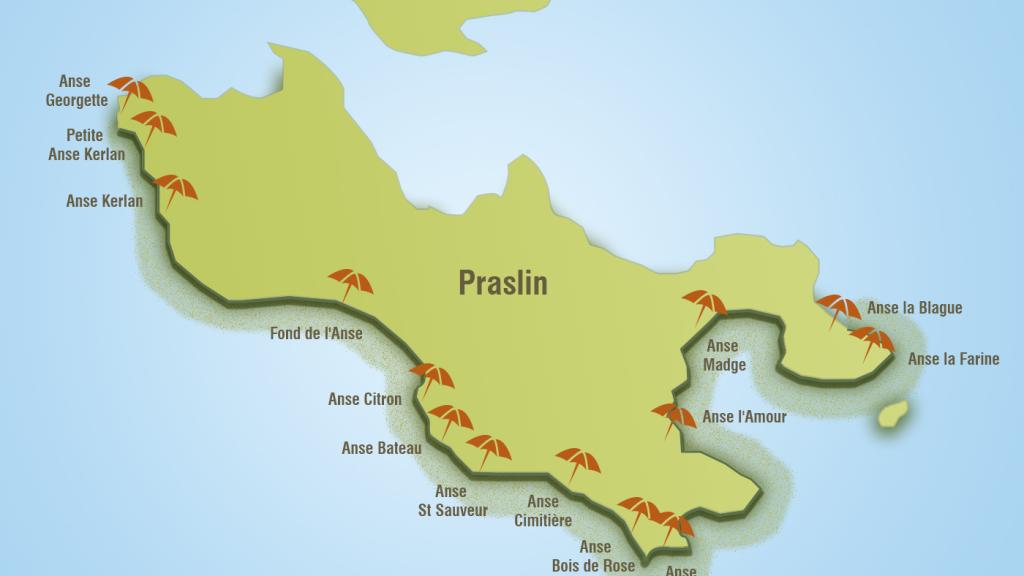Seychelles Climate
When is the best time to go to the Seychelles?
The best time to go to the Seychelles is generally between May and October thanks to the sea breeze which blows during this time. Those wishing to go diving or snorkelling may prefer to go in April, May, or the last three months of the year thanks to the increased underwater visibility during these months.
Another answer to the same question could be that there is no "best time to go", as the Seychelles benefits from high summer temperatures all year-round. Generally, the temperatures are similar to midsummer in Central Europe, although humidity often reaches 80% of even more. For this reason, many people find the aforementioned sea breeze a welcome relief.
Average Temperatures in the Seychelles
Other Factors to Consider
The Seychelles lies in the sphere of influence of the monsoon and trade winds, which may also affect when you decide to visit the Seychelles. From May to September, the winds blow from the south-east, while from December to March they blow from the north-west. The transitional period in April and October/November takes with it the sea breeze, so the Seychelles feels hotter during these months.
The trade winds may make conditions more pleasant above the water, but they do decrease visibility underwater too. Therefore, anyone wishing to go diving or snorkelling extensively during their holiday should choose April, May, October, November, or December for their trip. On the other hand, those wishing to go sailing or windsurfing should definitely time their trip for between May and October thanks to the comparatively calm weather conditions. Please note, however, that some beaches experience high tides at this time, making it unsafe to swim in the sea in certain places.
Climate in the Seychelles
The Seychelles climate is tropical, with daily temperatures of between 24 and 30 °C (75 - 86 °F). The ocean temperature stays at around 26 °C (79 °F) all year-round. Even in the early morning hours, the temperature in the Seychelles does not usually fall below 20 °C (68 °F). The equatorial location of the Seychelles determines the length of day. In theory, each day is almost exactly twelve hours long (6.00 - 18.00 local time), but there are usually between 5 and 8 hours of bright daylight each day, depending on cloud cover.
How much does it rain in the Seychelles?
The Seychelles does experience rain from time to time due to its tropical location, often in the evening or at night, but usually only for a short time. The wettest months of the year are generally December, January, and February, with the summer months of June, July, and August being the driest months of the year.
Seychelles Climate Tables
| Mahé | Jan | Feb | Mar | Apr | May | Jun | Jul | Aug | Sep | Oct | Nov | Dec |
|---|---|---|---|---|---|---|---|---|---|---|---|---|
| Average Temp. (°C) | 27 | 28 | 28 | 28 | 28 | 27 | 26 | 26 | 27 | 27 | 27 | 27 |
| Hours of Sunshine/Day | 5 | 6 | 7 | 8 | 8 | 8 | 8 | 7 | 7 | 8 | 7 | 6 |
| Water Temperature (°C) | 28 | 27 | 28 | 27 | 26 | 25 | 23 | 23 | 23 | 26 | 25 | 27 |
| Precipitation (mm) | 396 | 208 | 171 | 178 | 171 | 61 | 70 | 87 | 105 | 170 | 164 | 301 |
| Rainy Days per Month | 9 | 5 | 6 | 6 | 6 | 3 | 3 | 4 | 4 | 5 | 5 | 10 |
| Praslin | Jan | Feb | Mar | Apr | May | Jun | Jul | Aug | Sep | Oct | Nov | Dec |
|---|---|---|---|---|---|---|---|---|---|---|---|---|
| Average Temp. (°C) | 27 | 27 | 28 | 28 | 28 | 27 | 26 | 26 | 27 | 27 | 27 | 27 |
| Hours of Sunshine/Day | 5 | 6 | 7 | 8 | 8 | 8 | 8 | 7 | 7 | 8 | 7 | 6 |
| Water Temperature (°C) | 28 | 27 | 28 | 27 | 26 | 25 | 23 | 23 | 23 | 26 | 25 | 27 |
| Precipitation (mm) | 295 | 172 | 160 | 124 | 135 | 116 | 53 | 99 | 130 | 141 | 179 | 311 |
| Rainy Days per Month | 9 | 5 | 6 | 6 | 6 | 3 | 3 | 4 | 4 | 5 | 5 | 10 |
Trade Winds
Between May and September, the so-called south-east trade wind blows in this part of the Indian Ocean. The wind is mostly even, and provides a refreshing breeze on the beaches, disturbing the ocean surface too. Between December and February the north-west trade wind blows weakly on the Seychelles islands. Between these two periods, there is almost no wind, and the sea remains calm all the time. Thanks to their location, the Seychelles are never affected by bad storms. In fact, they generally only experience gentle breezes from such storms happening thousands of kilometres away.
The trade winds from June to September can bring with them seaweed, especially on Praslin. Although this may spoil the white, pristine beaches that some holidaymakers may have in their head, in reality it is a positive sign that the underwater world of the Seychelles is thriving. On the chart, you can see the worst-affected parts of Praslin, where you can expect to see a build-up of seaweed during the south-east trade winds. That said, the beaches on the other side of the island are generally free of seaweed, even during this time.

Tide
The tide changes every six hours in the Seychelles. Your accommodation will be able to provide you with current tide conditions, and may even have tide tables available, allowing you to plan your day more easily.
Find the Best Time to Travel!
